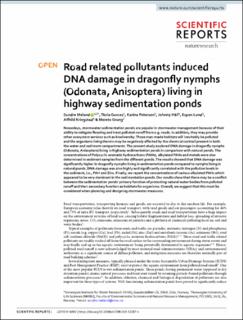| dc.contributor.author | Meland, Sondre | |
| dc.contributor.author | Gomes, Tania | |
| dc.contributor.author | Petersen, Karina | |
| dc.contributor.author | Håll, Johnny | |
| dc.contributor.author | Lund, Espen | |
| dc.contributor.author | Kringstad, Alfhild | |
| dc.contributor.author | Grung, Merete | |
| dc.date.accessioned | 2020-02-26T19:18:46Z | |
| dc.date.available | 2020-02-26T19:18:46Z | |
| dc.date.created | 2020-02-16T14:32:09Z | |
| dc.date.issued | 2019 | |
| dc.identifier.citation | Scientific Reports. 2019, 9 . | en_US |
| dc.identifier.issn | 2045-2322 | |
| dc.identifier.uri | https://hdl.handle.net/11250/2644057 | |
| dc.description.abstract | Nowadays, stormwater sedimentation ponds are popular in stormwater management because of their ability to mitigate flooding and treat polluted runoff from e.g. roads. In addition, they may provide other ecosystem services such as biodiversity. These man-made habitats will inevitably be polluted and the organisms living therein may be negatively affected by the chemical cocktail present in both the water and sediment compartments. The present study explored DNA damage in dragonfly nymphs (Odonata, Anisoptera) living in highway sedimentation ponds in comparison with natural ponds. The concentrations of Polycyclic aromatic hydrocarbons (PAHs), alkylated PAHs and metals were also determined in sediment samples from the different ponds. The results showed that DNA damage was significantly higher in dragonfly nymphs living in sedimentation ponds compared to nymphs living in natural ponds. DNA damage was also highly and significantly correlated with the pollution levels in the sediment, i.e., PAH and Zinc. Finally, we report the concentrations of various alkylated PAHs which appeared to be very dominant in the sedimentation ponds. Our results show that there may be a conflict between the sedimentation ponds’ primary function of protecting natural water bodies from polluted runoff and their secondary function as habitats for organisms. Overall, we suggest that this must be considered when planning and designing stormwater measures. | en_US |
| dc.language.iso | eng | en_US |
| dc.rights | Attribution-NonCommercial-NoDerivatives 4.0 Internasjonal | * |
| dc.rights.uri | http://creativecommons.org/licenses/by-nc-nd/4.0/deed.no | * |
| dc.title | Road related pollutants induced DNA damage in dragonfly nymphs (Odonata, Anisoptera) living in highway sedimentation ponds | en_US |
| dc.type | Peer reviewed | en_US |
| dc.type | Journal article | en_US |
| dc.description.version | publishedVersion | en_US |
| dc.source.pagenumber | 15 | en_US |
| dc.source.volume | 9 | en_US |
| dc.source.journal | Scientific Reports | en_US |
| dc.identifier.doi | 10.1038/s41598-019-52207-4 | |
| dc.identifier.cristin | 1794473 | |
| dc.relation.project | Norges forskningsråd: 160016 | en_US |
| cristin.ispublished | true | |
| cristin.fulltext | original | |
| cristin.qualitycode | 1 | |

